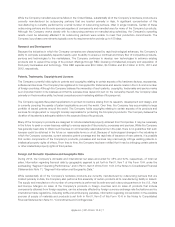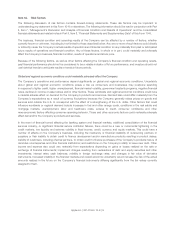Apple 2014 Annual Report Download - page 18
Download and view the complete annual report
Please find page 18 of the 2014 Apple annual report below. You can navigate through the pages in the report by either clicking on the pages listed below, or by using the keyword search tool below to find specific information within the annual report.Investment in new business strategies and acquisitions could disrupt the Company’s ongoing business and present risks
not originally contemplated.
The Company has invested, and in the future may invest, in new business strategies or acquisitions. Such endeavors may
involve significant risks and uncertainties, including distraction of management from current operations, greater than expected
liabilities and expenses, inadequate return of capital and unidentified issues not discovered in the Company’s due diligence.
These new ventures are inherently risky and may not be successful.
The Company’s business and reputation may be impacted by information technology system failures or network
disruptions.
The Company may be subject to information technology system failures and network disruptions. These may be caused by
natural disasters, accidents, power disruptions, telecommunications failures, acts of terrorism or war, computer viruses,
physical or electronic break-ins, or other events or disruptions. System redundancy may be ineffective or inadequate, and the
Company’s disaster recovery planning may not be sufficient for all eventualities. Such failures or disruptions could prevent
access to the Company’s online stores and services, preclude retail store transactions, compromise Company or customer
data, and result in delayed or cancelled orders. System failures and disruptions could also impede the manufacturing and
shipping of products, delivery of online services, transactions processing and financial reporting.
There may be breaches of the Company’s information technology systems that materially damage business partner and
customer relationships, curtail or otherwise adversely impact access to online stores and services, or subject the Company
to significant reputational, financial, legal and operational consequences.
The Company’s business requires it to use and store customer, employee and business partner personally identifiable
information (“PII”). This may include, among other information, names, addresses, phone numbers, email addresses, contact
preferences, tax identification numbers and payment account information. Although malicious attacks to gain access to PII
affect many companies across various industries, the Company is at a relatively greater risk of being targeted because of its
high profile and the amount of PII it manages.
The Company requires user names and passwords in order to access its information technology systems. The Company also
uses encryption and authentication technologies designed to secure the transmission and storage of data and prevent access
to Company data or accounts. As with all companies, these security measures are subject to third-party security breaches,
employee error, malfeasance, faulty password management, or other irregularities. For example, third parties may attempt to
fraudulently induce employees or customers into disclosing user names, passwords or other sensitive information, which may
in turn be used to access the Company’s information technology systems. To help protect customers and the Company, the
Company monitors accounts and systems for unusual activity and may freeze accounts under suspicious circumstances,
which may result in the delay or loss of customer orders.
The Company devotes significant resources to network security, data encryption and other security measures to protect its
systems and data, but these security measures cannot provide absolute security. To the extent the Company was to
experience a breach of its systems and was unable to protect sensitive data, such a breach could materially damage business
partner and customer relationships, and curtail or otherwise adversely impact access to online stores and services. Moreover, if
a computer security breach affects the Company’s systems or results in the unauthorized release of PII, the Company’s
reputation and brand could be materially damaged, use of the Company’s products and services could decrease, and the
Company could be exposed to a risk of loss or litigation and possible liability. While the Company maintains insurance coverage
that, subject to policy terms and conditions and subject to a significant self-insured retention, is designed to address certain
aspects of cyber risks, such insurance coverage may be insufficient to cover all losses or all types of claims that may arise in the
continually evolving area of cyber risk.
Apple Inc. | 2014 Form 10-K | 16
























